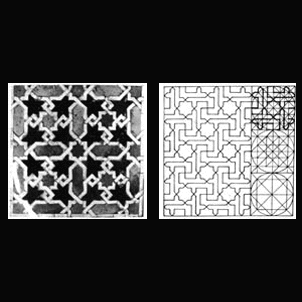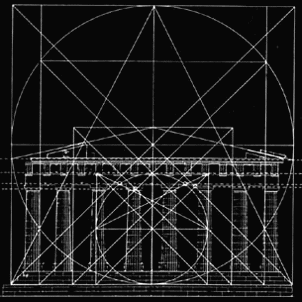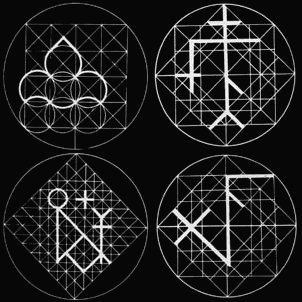- Lesson One: The Number One
- ... in Geometry
- ... in Nature
- ... in Culture
- "Uroboros" (related artwork by the author)
- "Creation" (related artwork by the author)
- Lesson Two: The Square Root of Two
- ... in Geometry
- ... in Nature, Part 1
- ... in Nature, Part 2
- ... in Culture, Part 1
- ... in Culture, Part 2
- "Duality" (related artwork by the author)
- Lesson Three: The Square Root of Three
- ... in Geometry
- ... in Nature
- ... in Culture
- "Vesica" (related artwork by the author)
- Lesson Four: Phi, or the Golden Proportion
- ... Intro, Part 2
- ... Intro, Part 3
- ... in Geometry
- ... in Nature
- ... in Nature, Part 2
- ... in Culture
- "The Flower of Phi" (related artwork by the author)
- Lesson Five: The Five Perfect Solids
- ... Intro, Part 2
- ... The Tetrahedron
- ... The Octahedron
- ... The Cube
- ... The Icosahedron
- ... The Dodecahedron
Specific Use of the Square Root of Two in Human Culture
Muslim art and architecture is well known for it's firm foundation in the theories of Sacred Geometry. By clicking the image icon below, an example of Islamic tile work is presented which is based on a square root of two matrix. The image on the right shows how the left-hand image can be broken down to reveal the matrix on which it is based.
 Taken From: Robert Lawlor's book Sacred Geometry; Philosophy and Practice, Thames and Hudson, 1982
Taken From: Robert Lawlor's book Sacred Geometry; Philosophy and Practice, Thames and Hudson, 1982In order to fully understand how the matrixes presented relate to the square root of two, one must take a compass and straightedge and measure the proportions and relations between different lines in a given matrix. In the case of the matrix presented in the image above and to the right, one will find that all the lines in the grid created at the fathest right of the matrix relate in proportion to one another by the square root of two, or an exponential power thereof.
The idea is that when an artwork is created with many of its lines and proportions based on such a proportionate grid, the square root of two is projected visually at the observer. Most observers would never be consciously aware of the fact, unless they were to analyze the artwork with a compass and straightedge - and that is assuming they would know what proportions they were searching for. But the idea is that the proportion is being emblazed into the observer's subconscious. At some level the observer's brain, which intrinsically searches for such proportions in the environment around it, acknowledges the pure representation that it is witnessing.
 Taken From: Robert Lawlor's book Sacred Geometry; Philosophy and Practice, Thames and Hudson, 1982
Taken From: Robert Lawlor's book Sacred Geometry; Philosophy and Practice, Thames and Hudson, 1982Here we see such a root two matrix as we are describing laid over the façade of the Parthenon. Both the Greeks and the Romans used Sacred Geometry intrinsically in their art and architecture - the Greeks having learned Sacred Geometry from the Egyptians, and the Romans having learned it from the Greeks.
Sacred Geometry was passed from the Romans to European Medieval civilization via the stonemason tradition. Pictured below are four "Mason Marks" - symbols created by individual Masons that were carved into the stones that they worked with in order to distinguish their work from one another - a sort of signature symbol. When we superimpose a matrix based on the square root of two upon these marks (the marks consist of the darker lines in the images), it becomes obvious that these symbols were much more than asthetic designs. Apparently, the Masons were quite dedicated to employing Sacred Geometry in all of their works, even down to the signature marks they used to sign their their works.
 Taken From: Matila Ghyka's book The Geometry of Art and Life, Dover, 1977
Taken From: Matila Ghyka's book The Geometry of Art and Life, Dover, 1977

